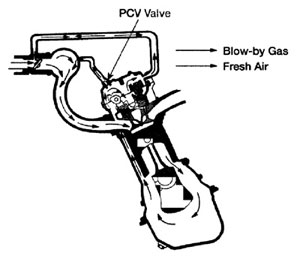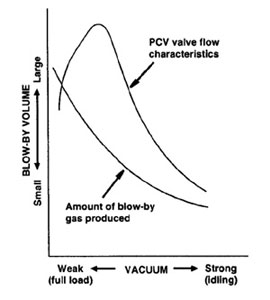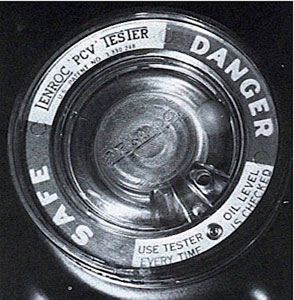By Roy Berndt
I am certain that each and every one of you have, at some time in your life, experienced the horrific event of having the “wind” knocked out of you. If you can remember back to the first time it ever happened, before you knew that you would in fact breathe again, it was like you were facing death right in the eye.
Well, imagine if you can, that same thing happening to an engine.
OK, it may be a stretch, but I had to come up with something that would get everyone’s attention. And, in fact, when you have a PCV system that is not working properly, you have an engine that can no longer breathe properly. Not the cylinders but the internal crankcase.

Why would I spend time with what should be “basic” information? Because it may actually be the single-most common factor contributing to issues of premature failure or customer dissatisfaction with a remanufactured engine. Do you recognize any of these symptoms of a potentially ineffective or inoperative PCV system: oil consumption (without smoking) fouled plugs, rough idle, plugged and sticking oil rings, rapid/premature engine wear, ruptured gaskets and seals, oil in the air cleaner and potential detonation? Each can be explained, and none of them is a characteristic that any customer would consider acceptable for a freshly remanufactured engine.
Let’s go through a few of the basics of how the system works (if you know all there is to know then just skip this paragraph). The Positive Crankcase Ventilation (PCV) is a system that was developed to remove harmful vapors from engines and prevent those vapors from being expelled in the atmosphere (see Figure 1).
It does this by using manifold vacuum to draw vapors from the crankcase into the intake manifold to be burned with the normal air/fuel mixture. The flow is controlled by the PCV valve in order to meter the amount of vapor introduced into the combustion process. Blow-by gases optimally should be removed at the same rate they enter the crankcase (see Figure 2).

At low rpm (idle) there is minimal blow-by, but that increases during higher rpm/load operation. The PCV valve must control the vapor evacuation accordingly. The PCV valve flow characteristics are directly proportional to manifold vacuum that also increases and decreases in relation to load and rpm.
A neglected or poorly operating PCV system will quickly contaminate the engine oil and heavy sludge accumulations will begin to form. Imagine dumping water and acid into your engine oil on a daily basis: how do you think that would impact the bearings, pistons and oil characteristics? For that matter, how long do you think the engine would last by doing that? That is exactly what an improper functioning PCV system will do because that is what the combustion process blow-by contains.
The other side of the coin is to have a system dumping huge amounts of PCV into the intake manifold and contaminating the air/fuel mixture creating a recipe for rough idle and even stalling of the engine.
Carbon is one of the best protections against elevated combustion temperatures and pressures, not too unlike a ceramic coating. Those elevated pressures and temperatures are more commonly referred to as detonation, which can result in as much as 300 times normal combustion pressures. Not a good scenario for head gaskets, pistons, rings or bearings.
A fresh engine installation is like a newborn baby: it is completely defenseless against external forces. Fresh components in the combustion chamber such as pistons, rings, intake and exhaust valves have no carbon coating on them as of yet.
Of course, just replacing a PCV valve does not effectively account for a proper functioning system. Hoses deteriorate and clog over time and if not replaced along with the PCV valve at the time of a new/remanufactured engine install, could render the PCV system relatively ineffective and catastrophic for the engine’s effective life cycle.
Testing The System
Testing the PCV system is relatively easy and can be done a number of different ways:
Pinching: After running the engine up to operating temperature and allowing it to stabilize at idle, pinch or block off the hose between the vacuum source and the PCV valve. The engine should typically drop 50-80 rpm. If the engine does not change, check the PCV valve and system hoses for blockage. Replace components as necessary and retest.
Vacuum: Run the engine up to operating temperature. Shut the engine off and block off the fresh air source to the engine. This would typically be the hose coming from the air cleaner to the rocker cover. Remove the dipstick tube and connect a vacuum-pressure gauge to the dipstick tube. Restart the engine and allow it to stabilize at idle. Then take a reading of your vacuum-pressure gauge. You should read 1-3˝ of vacuum with a normally operating PCV. If you have 0˝ of vacuum or even pressure you have problems.
If the engine has an external air leak you will not have an effective PCV system. This could be a leaking front cover, rocker cover, oil pan gasket, manifold end gaskets or any other host of potential leaks.
There is a way to look for these leaks but can be extremely dangerous to the engine if not done correctly. CAUTION: Follow this information precisely to avoid damaging the engine!
Apply no more than 5 psi of air pressure to the dipstick tube (this is critical: no more then 5 psi!). Spray down the gasket sealing surfaces of those gaskets indicated above with a soapy water solution and look for bubbles. Where there are bubbles there are leaks. I will say it again, apply no more than 5 psi to the dipstick tube or you may have every gasket leaking.
If the PCV system has been building pressure you will burn up crank seals in the engine. When within a pressurized system the PCV does not allow oil to flow properly to lubricate the lips and they can run dry and burn up. Intake manifold runners that are wet are going to be PCV related as well, but intake runners of the cylinder head saturated on “V” engines (with a dry intake manifold) are the result of leaks of the intake manifold gasket on the bottom side drawing PCV into the cylinder head runners, not the PCV system. This will also show as excessive vacuum on a PCV test.

There is another vacuum test that uses a gauge placed in the filler cap position (see Figure 3). It’s reliable, but it may or may not fit your application filler cap.
A final comment: all PCV valves are not created equal. They have different flow characteristics that are specific to each engine application and may even be specific to particular platforms using the same engine. You may run into instances of excessive PCV flow and oil consumption with a new PCV valve. If that situation comes up, be certain to go back to an OE PCV valve. It may solve your problem. Do the PCV vacuum test between them and see if there is a difference.
Roy Berndt has decades of machine shop experience. He is the Program Manager for LKQ Remanufacturing, a PER in Springfield, MO.
